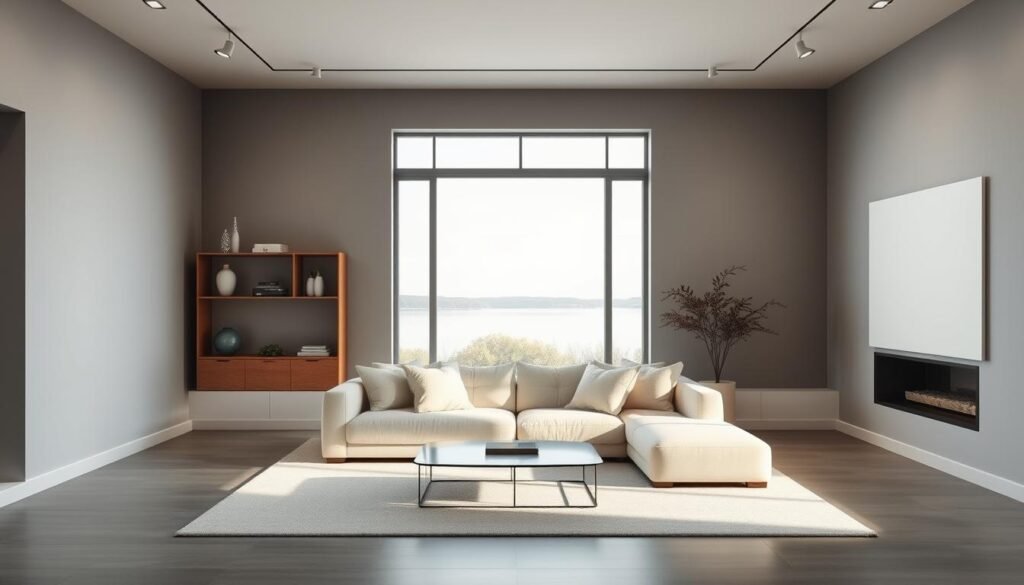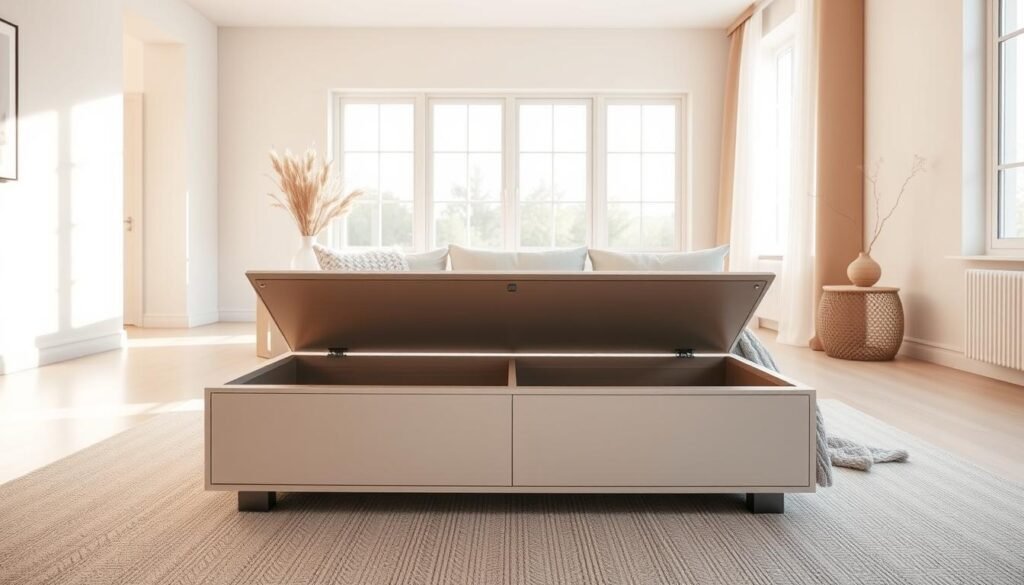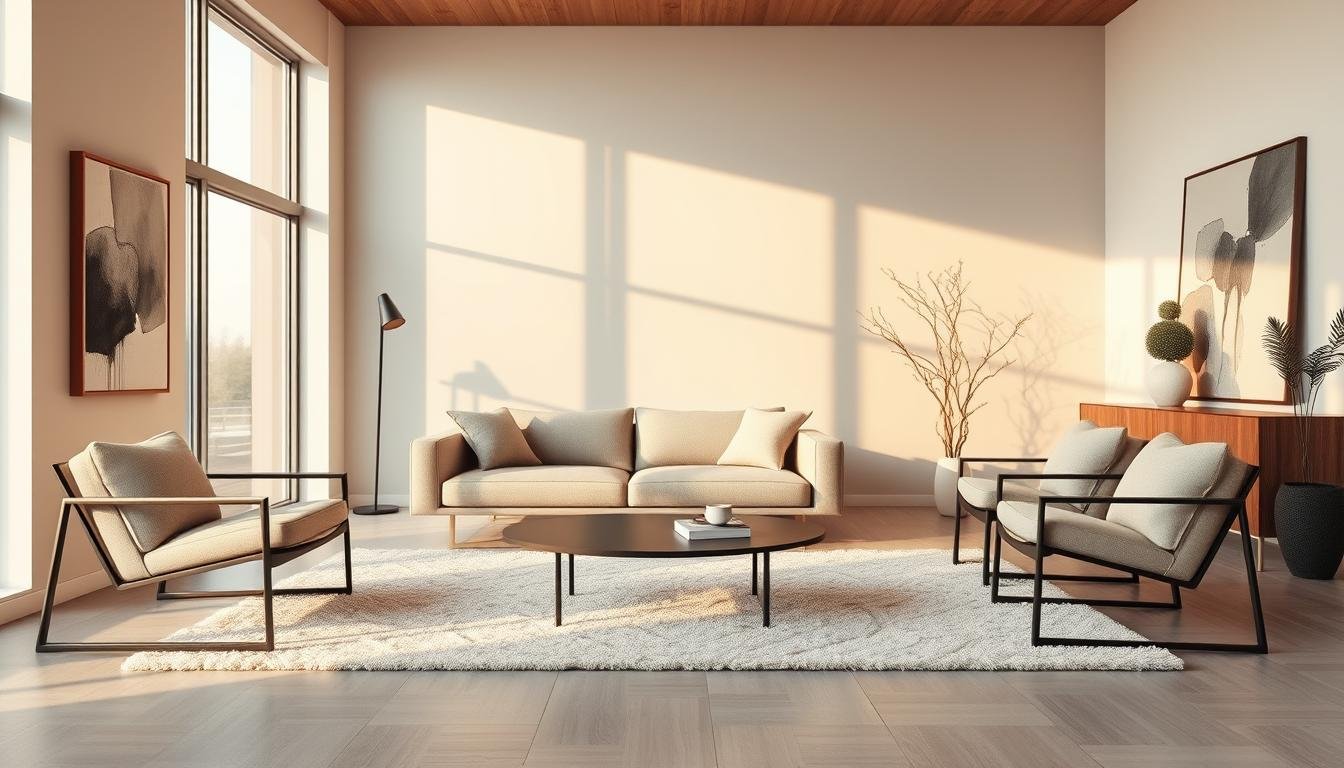This post may contain affiliate links. When you purchase through links on our site, we may earn an affiliate commission.
Over the years, I’ve watched design preferences shift, but one style continues to stand out: spaces that prioritize clarity and purpose. While maximalism once dominated, there’s a growing appreciation for thoughtful simplicity in homes. Today’s approach isn’t about empty rooms or rigid rules—it’s about creating warmth through intentional choices.
What excites me most is how modern pieces blend clean shapes with natural textures. Think smooth wood accents paired with soft fabrics or metallic finishes that catch the light. These combinations make rooms feel lived-in rather than sterile, proving that functional design can still radiate personality.
Through my work, I’ve seen homeowners gravitate toward items that serve multiple roles without overwhelming a space. A well-crafted coffee table might double as storage, or a modular sofa adapt to different layouts. This shift reflects a deeper desire to curate rather than accumulate—a philosophy that values lasting quality over fleeting fads.
The result? Homes that feel balanced and inviting. By focusing on essentials, we create environments that support both relaxation and creativity. It’s not about stripping away character but highlighting what truly matters in our daily lives.
Key Takeaways
- Modern minimalism emphasizes warmth and personalization over stark aesthetics
- Natural materials and multifunctional furniture enhance comfort and practicality
- Intentional design choices help maintain clutter-free, calming spaces
- Quality craftsmanship is prioritized to create lasting value in home decor
- Balancing simplicity with functionality leads to versatile, inviting rooms
Discovering the Essence of Minimalist Design
I’ve always believed great design speaks through purposeful silence. It’s about creating rooms where sunlight dances across uncluttered surfaces, and every object earns its place. As designer Katie Harbison notes:
“A well-considered and restrained palette is essential. Allowing for natural light, tonal textures, and interesting silhouettes transforms mere spaces into experiences.”
https://www.youtube.com/watch?v=x-V8C8Xj9ko
Where Form Meets Purpose
What fascinates me most is how clean lines become functional art. A chair isn’t just seating—it’s a sculptural statement. Shelving systems morph into room dividers, proving beauty and practicality aren’t rivals. This harmony turns daily routines into moments of quiet appreciation.
The Rhythm of Restraint
I’ve learned that empty walls can sing louder than crowded galleries. By choosing three impactful pieces over fifteen forgettable ones, we create visual breathing room. Textured throw blankets or a single ceramic vase add warmth without chaos. It’s editing, not erasing.
Natural light plays lead actor in these designs. I position mirrors to amplify morning sun and select sheer curtains that soften afternoon glare. This approach builds connection with outdoor rhythms, making interiors feel alive rather than staged.
The Evolution from Maximalism to Warm Minimalism
Design philosophies evolve, but few transformations feel as personal as the move toward warm minimalism. As Simonpietri observes, this 21st-century shift blends airy openness with tactile comfort—a far cry from the stark, impersonal spaces of earlier decades. It’s about creating rooms that whisper calm rather than shout austerity.
Shifting from Clutter to Calm Spaces
I’ve watched clients replace chaotic decor with intentional simplicity. Instead of sterile white boxes, they’re choosing textured linens and mohair throws that invite touch. Earthy paint colors like clay beige and muted sage now anchor rooms, proving neutral doesn’t mean lifeless.
Hidden storage has become my secret weapon. A bench with lift-up seating or floating shelves with discreet compartments keeps daily essentials out of sight. This approach respects the need for functional spaces without visual noise.
Incorporating Hidden Storage and Soft Neutrals
Soft neutrals work magic. I’ve seen warm grays and creamy ivories make rooms feel lived-in compared to harsh bright whites. These tones pair beautifully with raw wood accents or hand-thrown pottery, adding character through imperfect finishes.
Multifunctional furniture bridges style and practicality. A console table might hide charging stations, while ottomans offer seating and storage. These solutions honor our need for order without sacrificing warmth.
| Element | Traditional Minimalism | Warm Minimalism |
|---|---|---|
| Color Palette | Pure whites | Earthy neutrals |
| Materials | Polished metals | Raw wood, stone |
| Textures | Smooth surfaces | Nubby fabrics |
| Storage | Visible organization | Disguised compartments |
This design evolution isn’t about rules—it’s about crafting spaces that hug you back. By balancing clean lines with organic materials, we create rooms that feel both serene and deeply human.
Exploring Sleek Minimalist Furniture Trends
Modern interiors are embracing a new language of form. What excites me most is how today’s functional items blur the line between utility and gallery-worthy art. This approach lets spaces breathe while making bold statements through carefully chosen elements.
Sculptural and Functional Furniture Pieces
I’ve curated homes where curved sofas become conversation starters. Their rounded edges soften angular layouts, proving practicality doesn’t require rigidity. Take flat-front cabinets—their smooth surfaces create rhythm in kitchens without shouting for attention.

These pieces solve two problems: storage needs and visual interest. A marble coffee table I recently styled doubled as a sculptural centerpiece. It eliminated the need for extra decor while anchoring the room’s layout.
Emphasis on Natural Materials and Clean Lines
Raw wood grains and unpolished stone dominate my projects now. They add tactile warmth that synthetic materials can’t replicate. I pair them with crisp silhouettes—think oak dining tables with knife-edge legs—to balance organic textures with precision.
This design philosophy celebrates simplicity without coldness. By letting material imperfections shine through streamlined forms, we create spaces that feel both intentional and inviting. The result? Rooms that whisper elegance rather than declutter demands.
Integrating Minimalist Design into Various Rooms
Adapting clean design across different areas requires balancing form and function. Through my projects, I’ve found that each space tells its own story while maintaining a cohesive visual language. The secret lies in honoring a room’s purpose without compromising simplicity.

Transforming Living, Dining, and Bedroom Spaces
Living areas thrive with modular seating that adapts to gatherings or solo relaxation. I often pair low-profile sofas with textured rugs to ground the space without clutter. Built-in shelving units keep essentials accessible yet discreet.
In dining zones, I focus on tables with clean silhouettes. These become natural hubs for connection when paired with slim-profile chairs. Lighting plays a key role—a single pendant lamp often provides both illumination and artistic flair.
Bedrooms benefit most from hidden storage solutions. Flat-front cabinets in built-in wardrobes maintain visual harmony, while soft ivory linens replace stark whites. I add depth through layered bedding in alabaster tones, topped with a striking headboard as the room’s focal point.
| Room | Key Element | Benefit |
|---|---|---|
| Living | Modular seating | Flexible layouts |
| Dining | Slim chairs | Encourages interaction |
| Bedroom | Built-in wardrobes | Seamless storage |
Through trial and error, I’ve learned that successful decor adapts rather than imposes. By letting each room’s function guide material choices and layouts, we create homes that feel both intentional and effortlessly livable.
Embracing Clean Surfaces and Hidden Storage Solutions
Creating a serene home starts with the spaces we touch and see every day. Through my projects, I’ve seen how cleared countertops and open shelves transform rooms. They let natural light bounce freely, making even compact areas feel expansive.

My approach centers on surfaces that serve a purpose. A kitchen island stays bare except for a handcrafted bowl—functional yet artistic. In living areas, floating shelves display only what sparks joy, proving less truly is more.
Maximizing Functionality with Minimal Clutter
Smart storage solutions make this possible. I’ve designed benches with hidden compartments and cabinets that blend into walls. These tricks keep daily essentials accessible but invisible, maintaining visual calm.
It’s about balance. A client’s entryway now features a console with secret drawers for keys and mail. The surface holds just a sculptural lamp—proof that practicality and beauty coexist.
By prioritizing intentional surfaces and concealed storage, homes gain both clarity and purpose. This method doesn’t restrict life—it creates space for what truly matters.
A Closer Look at Iconic Furniture Pieces
Iconic furniture shapes our daily experiences in subtle yet profound ways. Through countless design projects, I’ve discovered how foundational items become the quiet heroes of harmonious spaces. Their power lies in balancing bold statements with everyday practicality.
Coffee Tables as Living Room Anchors
I’ve styled homes where a round wooden coffee table transformed entire layouts. Its organic curves soften angular seating arrangements while providing essential surface space. One client’s cloud-white sectional gained depth when paired with a matte black table—proof that contrast creates visual rhythm.
Dining areas demand similar intentionality. I choose tables with tapered legs and smooth tops that encourage lingering conversations. Chairs with slim profiles maintain airiness without sacrificing comfort. These pieces become stages for connection rather than mere functional objects.
Form Follows Function—Gracefully
My favorite designs solve problems beautifully. A recent project featured a coffee table with hidden drawers for remote controls and magazines. This fusion of clean lines and concealed storage epitomizes modern living—where clutter disappears but character remains.
I often mix curved and straight edges to add movement. A oval dining table paired with linear chairs creates dynamic tension. These combinations prove practical items can elevate spaces when crafted with care. The result? Rooms that feel curated, not calculated.
Minimalism in Material Selection and Color Palette
The magic of a room often lies in what it doesn’t say. Through years of design work, I’ve discovered that restrained material choices and intentional color schemes speak volumes. They create environments that feel both curated and effortlessly livable.
Whispers of Warmth Through Texture
I’ve seen weathered oak floors transform sterile rooms into welcoming retreats. By combining matte finishes with nubby linen throws, spaces gain depth without visual noise. Raw stone countertops paired with smooth ceramic vases create tactile contrast that invites touch.
| Element | Traditional Approach | Modern Minimalism |
|---|---|---|
| Foundation | Cool grays | Warm beige |
| Accent | Chrome fixtures | Brushed brass |
| Texture | Polished surfaces | Raw wood grain |
| Material | Synthetic blends | Organic fibers |
The Art of Less, Done Right
A tight palette works best when layers have purpose. I once designed a bedroom using only four tones: oat-colored walls, walnut furniture, ivory bedding, and a single terracotta pot. The result? A space that felt complete yet never crowded.
Bold accents shine when used like punctuation marks. A cobalt blue throw pillow or emerald green vase becomes memorable against neutral backdrops. This strategy maintains simplicity while allowing personality to peek through.
Natural materials do the heavy lifting in clean designs. Unstained wood shelves or rough-cut marble surfaces add character without overwhelming. They remind us that perfection lies in authenticity, not uniformity.
Drawing Inspiration from Global Design Philosophies
Cultural roots shape how we create meaningful spaces. My journey into design revealed surprising connections between Eastern restraint and Western functionality. These traditions teach us that true simplicity emerges from intentional choices rather than empty spaces.
Eastern Influences and Japanese Harmony
Studying Japanese homes transformed my approach. The use of tatami mats and shoji screens shows how natural elements foster calm. This philosophy values weathered wood over perfect finishes, proving beauty lives in authenticity.
Scandinavian Functionality Meets Bauhaus Logic
The Bauhaus movement taught me to celebrate raw materials through clean forms. Paired with Scandinavian practicality, this creates balance between purpose and aesthetics. Think wool throws on tubular steel chairs—warmth meeting industrial precision.
By blending these global design philosophies, we craft rooms that feel both grounded and innovative. It’s not about copying traditions, but understanding the wisdom behind their essential choices.

 using WordPress and
using WordPress and 
No responses yet